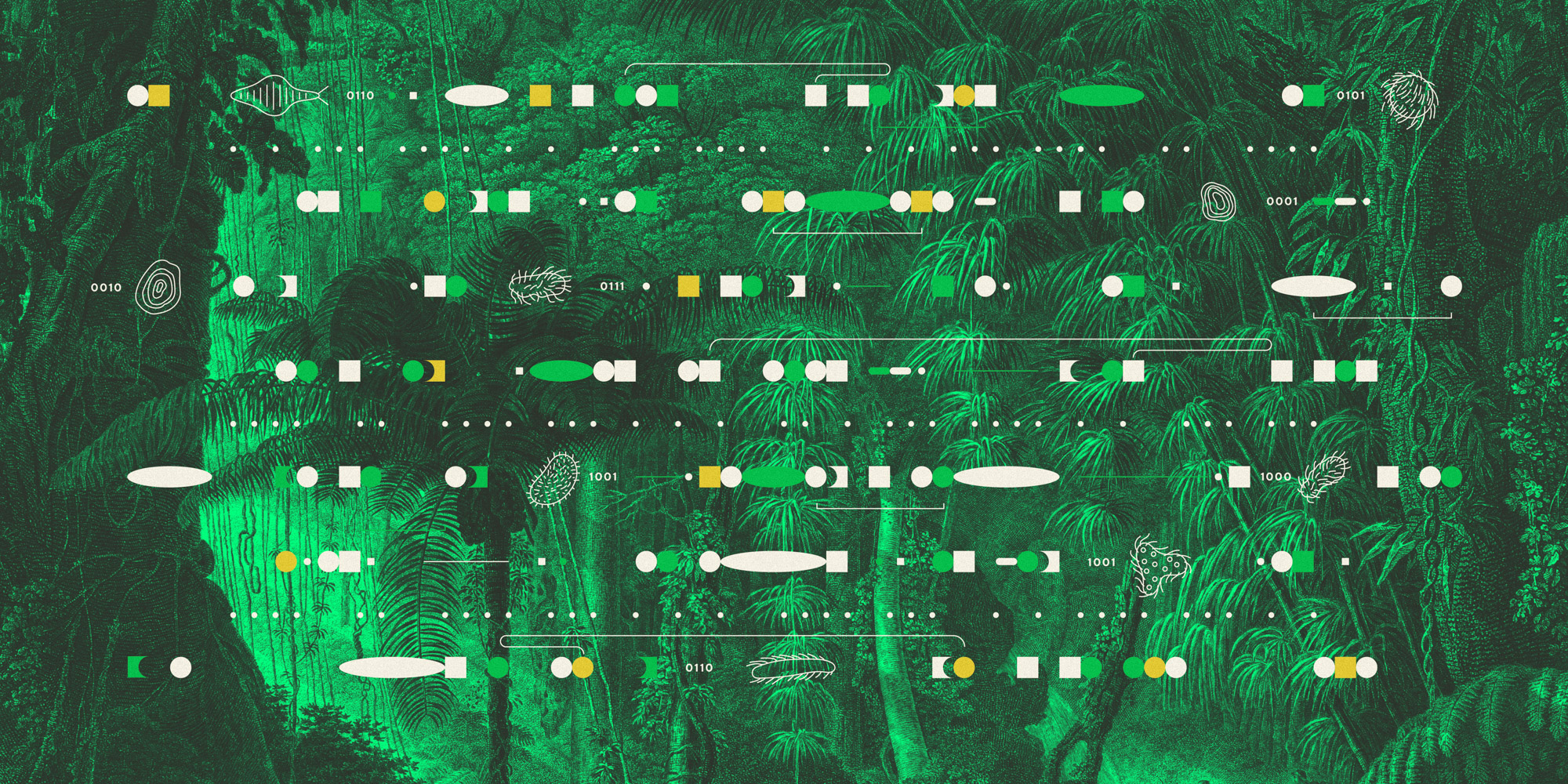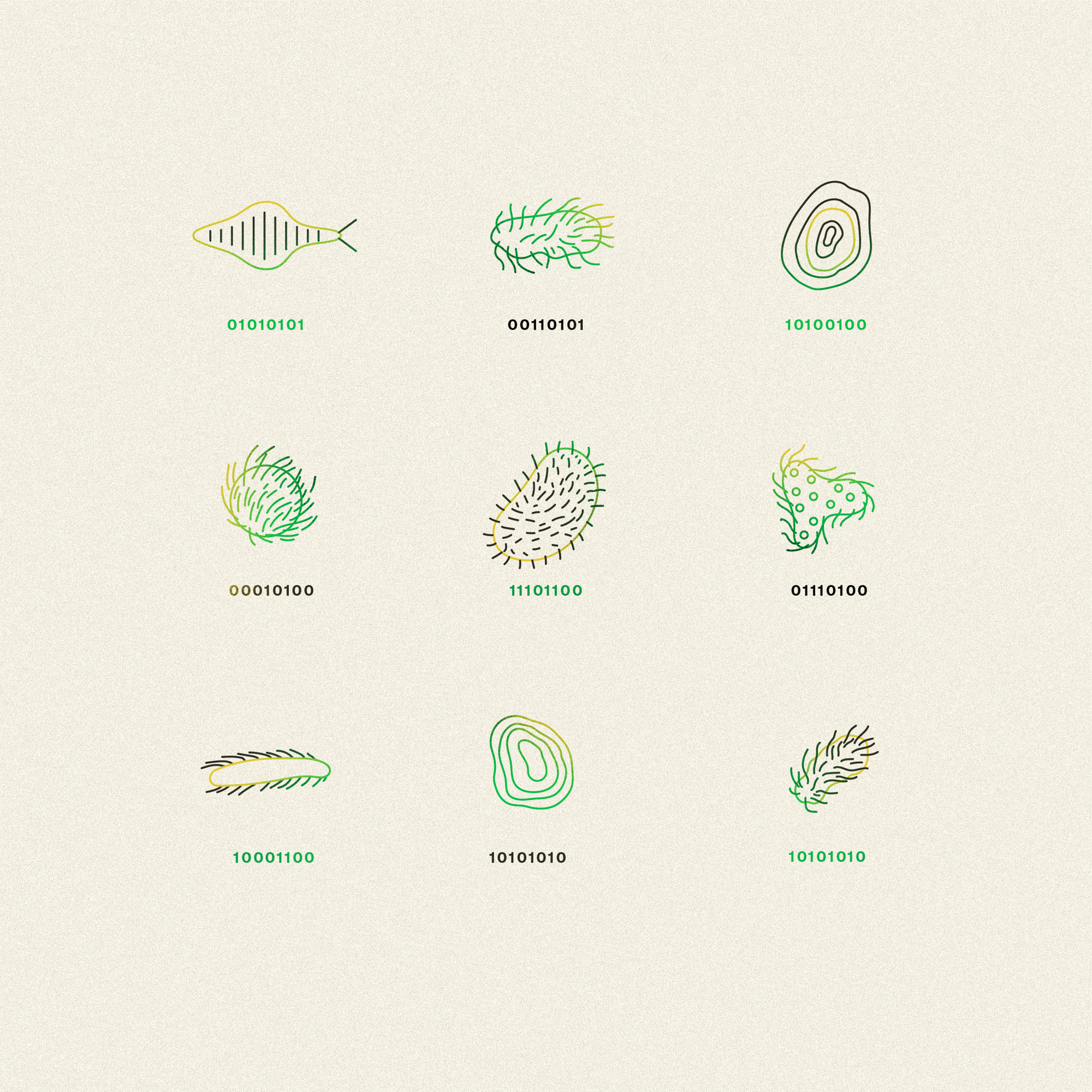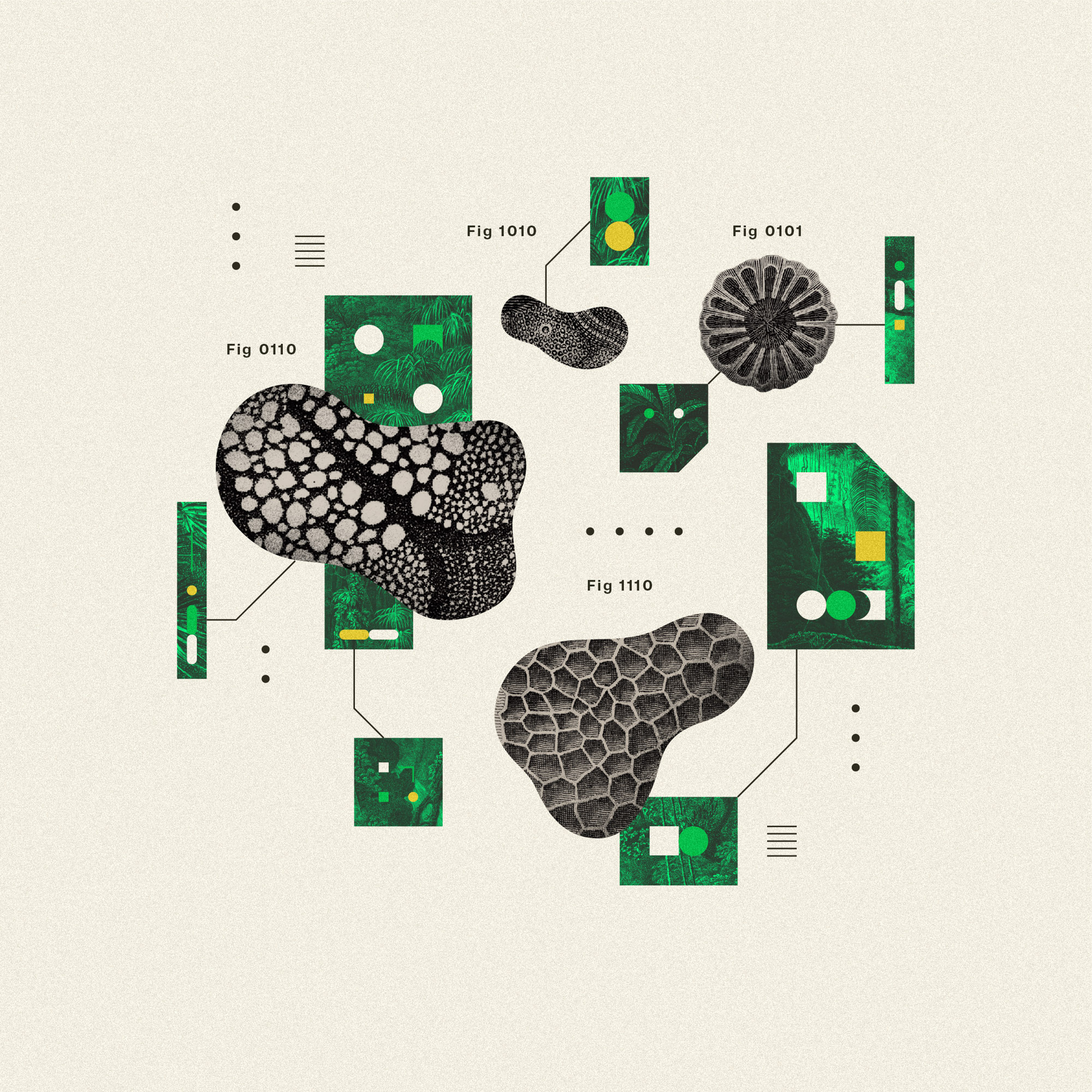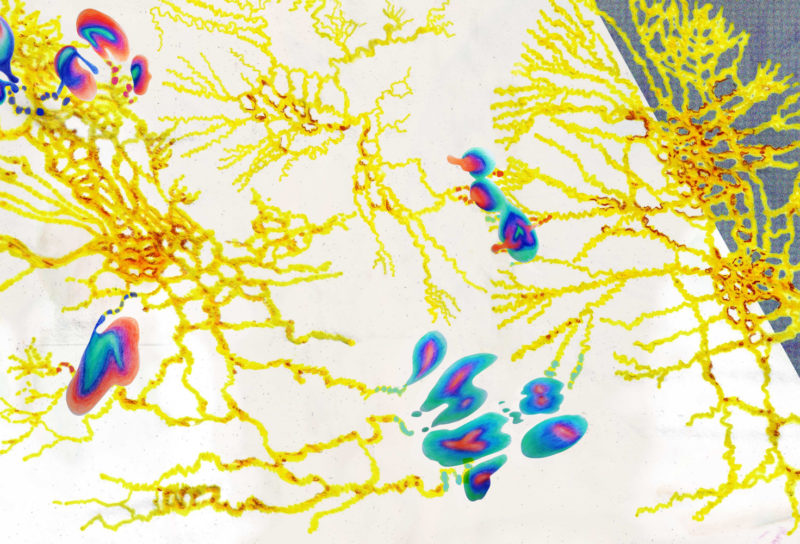In a grainy VHS recording from 1995, a delicate, unassuming man with a caterpillar mustache gazes intently at the camera. He’s lit like a Star Trek villain, wearing a bolo tie, surrounded by a Natural History display: birdcages, bones, dried flowers, and aquariums brimming with neon green plants and tropical fish. The only odd item out in this eccentric mise-en-scène is a large computer monitor, placed directly on the floor. A frantic flourish of harpsichord music fades as the man introduces himself. His name is Tom Ray. “I’m an evolutionary biologist,” he says. “I went to the rainforest to study evolution, but I found it very difficult because evolution is so slow. So I got the idea of trying to start evolution in the computer.”
Life, Death, and Competition
Tom Ray has had, he says, three “powerful ideas” in his life. The first two came to him when he was a teenager, in Norman, Oklahoma, in 1970. Resist mass extinction was the first, calling him to ecological conservation. Use psychedelics to probe the inner workings of the human mind was the second. These were relatively self-evident revelations, given the decade. But his third powerful idea, the one that would make him famous, landing him in Santa Fe, New Mexico, in a bolo tie, in this visionary light, is more of a head-scratcher: create artificial life.
“It really started over a game of Go,” he explains to me.
As a graduate student, he often spent nights studying in the Harvard Science Center’s cafeteria. On the night of his third big idea, he had company. The Cambridge Go club had set up their boards at nearby tables. Curious, he sat down with a solitary player and asked about the game, which he knew nothing about. Go is an ancient Chinese board game, where two players vie for territory with pebbles. Like chess, the simplicity of its rules belie the complexity of its play; the number of legal positions in the game is greater than the number of atoms in the observable universe. But that night in the Harvard cafeteria, the Go player described the game in existential terms: the pebbles lived or died, he explained, based on their proximity to free space. Ray smiled — as a Biology student, he understood life, death, and competition.
The player, a member of the MIT Artificial Intelligence lab, nodded sagely. “Did you know it’s possible to write a self-replicating computer program?”
“How do you do it?” asked Ray.
“It’s trivial.”
Far from it, thought Ray. He went back to studying tropical ecology, making good on his first powerful idea (resist mass extinction) by conducting field research in the rainforests of Costa Rica. He studied butterflies, beetles, ants, and plants — a fine life. His focus was tropical vines. By observing their furtive, migratory moments across the forest floor, he’d come to see them as “the primates of the plant kingdom,” and published the first paper documenting skototropism, the lesser-known inverse of a plant’s natural desire to turn towards the sun. Why would a vine turn away from the source of its life? It was an appropriate subject for a shy, somewhat eccentric biologist.
As he observed the rainforest’s hyper-competitive ecology, noting the way interesting and advantageous mutations in living organisms played out across the forest floor, the Go player’s glib pronouncement nagged at him. If it were indeed “trivial” to create a self-replicating computer program, he wondered, then what would happen if such programs were set to compete against one another, as organisms do in the wild? The idea took hold of Ray like a vine.
The Life of Flies
Benjamin Franklin once wrote a sentimental letter to a friend about the short lives of flies. Claiming to “understand all the inferior animal tongues,” he transcribed the soliloquy of an old-grey headed chimera fly, the elder of his race — a venerable seven hours old. “How very few of us continue so long!” lamented the old fly. “I have seen generations born, flourish, and expire…And I must soon follow them, for…I cannot expect to live above seven or eight minutes longer. What now avails all my toil and labor, in amassing honeydew on this leaf, which I cannot live to enjoy!”
Such evanescence may be tragic to the fly, but it’s a boon for the researcher. Biologists often work with short-lived organisms like fruit flies because their rapidly successive generations effectively speed the passage of time, making it easier to observe genetic changes. But evolution is a game that plays out over millions of years. From a human perspective, it’s impossible to observe in its entirety. This is why Tom Ray was so taken with the idea of sparking evolution in a computer. He wanted to see the whole game play out in real time.
At this point, Ray didn’t really know what a computer program was, in any meaningful sense. He’d used computers — even done some light programming (in C). But his understanding of the nuts and bolts was limited, and ended on his side of the screen. He was woefully under-equipped to act on his idea. “I couldn’t do a thing with it except imagine,” he later wrote. His powerful ideas always seemed to arrive early. This time, it would take nearly a decade for Ray to catch up.
In 1988, he bought his first personal computer, a “bottom of the line” Toshiba laptop he packed in his carry-on for a semester of research in Costa Rica. It would be the proving ground for his third powerful idea: create artificial life by seeding primitive code-organisms into a competitive digital environment. He started playing around with Borland’s Turbo C Compiler, a development environment for programming in C. Its accompanying Debugger software was a revelation: it was the first time he’d been able to see the physical manifestation of a program on screen. Suddenly, he could visualize the programs he was writing, and “walk through” them to see what they actually did. “I immediately saw that the path was open to me,” he remembers. “I could do this thing. It just took me over. Now I didn’t want to do anything else.”
Ray was up for tenure in the biology department of the University of Delaware, but his interest in traditional biology had been entirely supplanted by the notion of evolutionary computer programs. He read everything he could about computer architectures, operating systems, and programming languages — all while imagining his laptop as a pocket-world waiting to be inoculated with life.
The field of Artificial Life was new, and still largely theoretical. Ray discovered that a computer scientist named Christopher Langton had just organized the first Artificial Life workshop the previous year, and that he headed up an Artificial Life group at the Los Alamos National Laboratories. Thrilled, Ray set up a meeting. It did not go well.
In the short documentary produced by the Santa Fe Institute in 1995, the computer scientist Stephanie Forest — a specialist in genetic algorithms — remembers the meeting. “I thought it was hopeless,” she said. “Here was this guy who just walked in off the street, didn’t know anything about assembler code, and didn’t know anything about how real computers worked.” What Ray was proposing seemed, to the Artificial Life group, to be infeasible, even naive: computer languages are too brittle, they said, to withstand the kinds of mutations Ray had in mind.
Ray was not deterred. He was, after all, approaching his project from the perspective of evolutionary biology — not computer science. Genetic code, too, is brittle. And although random mutations of the genetic code “are almost always disastrous for the creatures born with them,” every once in a while, the creatures born with those random mutations find themselves better off than their parents. They are vanguards, turning points in evolution that change the course of things for their whole species. Rinse and repeat this process over millions of years, and you end up with sophisticated wetware like the human brain. Ray had a hunch that his digital organisms could behave the same way. Now he had to prove it.
“They never would have believed it unless I had done it,” he says.
Ray went home and wrote his self-replicating computer program himself, an 80-byte string of code he later dubbed “The Ancestor.” It was, as the Go player had advised, mostly trivial. The non-trivial part was creating an environment in which this program could live, mutate, and reproduce. Again, Ray drew on his fieldwork experience. If his notebook computer was a self-contained world, then its RAM memory would be the physical space occupied by his virtual creatures, its CPU their source of energy, and its operating system — which would determine the allocation of resources — the physics of the world itself. Like tropical vines on the rainforest floor, Ray’s creatures would compete for shared resources and jostle for dominance within a finite space. To the mix, he added nature’s cruelties: the possibility of mutation, in the form of a random code flip between ones and zeroes, and a “Reaper,” a program designed to kill off the oldest, most error-prone creatures. He named this new world Tierra.
It was rough around the edges, but it was a start. Ray intended to tinker for years, refining the code and running experiments. He didn’t expect his string of “Ancestor” code to do much more than mutate and glitch. But life, as they say, finds a way.
All Hell Breaks Loose
The mathematician John von Neumann first proposed the notion of self-replicating machines in the 1940s, and plotted the mathematical logic of such reproduction by borrowing a model conceived by his colleague, the mathematician Stanislaw Ulam. Ulam’s Cellular Automata — a grid of cells, each bearing a relationship to its neighbors determined by fixed rules — proved a useful way to observe unfolding patterns, which mapped surprisingly well to the natural world. Although von Neumann worked out his ideas before the discovery of DNA, he was ultimately correct about life’s underlying reproductive processes.
Christopher Langton observes that there is nothing in the charter of biology that restricts it to the study of carbon-based life: it’s just that, short of discovering extraterrestrial life, carbon-based life on Earth is the only form of life available for biologists to study. But life itself transcends biology, ALife researchers believe. As Langton writes, it’s “a property of form, not matter.” This form can be peeled away from matter and studied on its own in myriad ways: through hardware, by building robots, through wetware, in the pursuit of synthetic biology, and through software, as with Tom Ray’s Tierra. Whatever form it takes, Artificial Life reveals not only the processes of life as we know it, but new possibilities beyond known biological phenomena — “beyond life-as-we-know-it into the realm of life-as-it-could-be.”
On January 3rd, 1990, Tom Ray let the Ancestor free in the silicon jungle of Tierra. He left it to run overnight. When he returned in the morning, he was shocked to discover his virtual machine brimming with life. “All hell broke loose,” he later wrote. The self-replicating program had, indeed, replicated — and mutated, and replicated, and mutated again, all at megahertz speeds, accelerating the process of evolution like so many successive generations of fruit flies. Left alone, Ray’s software creatures had preyed on one another, and as a result Tierra was full of parasites — even hyper-parasites — which in turn produced tighter, more efficient strings of code as his creatures adapted and developed immunities. Tierra was unrecognizable, and it was alive.
“I was back in a jungle describing what evolution had created, but this time a digital jungle,” he marveled. “There was an amazing menagerie of digital creatures, unfolding through the process of evolution. Describing them was an adventure, because they inhabited an alien universe, based on a digital physics totally different from the physics inhabited by the life forms I knew and loved.”
Tierra was not a model, Ray takes pains to point out. In a model, the data in the computer system simulates something in the real world: a population of insects, for example, or weather phenomena. Tierra’s creatures were sui generis, competing for resources in a universe of Boolean logic, and related to living creatures by metaphor alone. Still, the mechanisms by which their populations reproduced and evolved were identical to the mechanisms of carbon-based evolution. “I like to say that Tierra was the second-known instance of evolution by natural selection after life on Earth,” Ray explains to me. Does that mean that Tierra’s software creatures were, in some real sense, alive? “Absolutely,” he says.
This, of course, depends on your definition of life. Ray’s creatures took their destinies into their own hands: even when Ray turned off Tierra’s random mutations, his creatures reproduced sexually, mingling their genes with one another to produce novel offspring. They cannibalized and preyed on one another, and fell into long periods of mutual interdependence, developing social cooperation. “I’m satisfied to define life as anything that self-replicates and evolves,” Ray says.
It was a limited life. Ray had hoped his creatures might achieve a sudden burst of complexity comparable to the Cambrian Explosion in Earth’s evolutionary history. But despite their initial creativity, his creatures’ evolution always plateaued after a certain point. Dozens of Artificial Life worlds followed Tierra. Today, the field of ALife is home to a veritable zoo of virtual creatures that flock, battle, and wobble. And yet the astoundingly creative open-endedness of biological evolution remains impossible to program. The billion year creative spree of evolution, which began with a single cell and flourished into the full diversity of life on Earth, cannot be reduced to an algorithm. Even understanding the process is an undertaking believed by some to be “the last grand challenge” of science.
It’s also inextricably bound to the pursuit of human-level Artificial Intelligence. While most AI researchers today take a top-down approach, reverse-engineering aspects of human intelligence, like learning, in isolation, some are beginning to see the benefits of a more expansive, bottom-up approach. As biologist Michael Levin — one of the scientific minds behind Xenobots, the world’s first living robots — noted in an interview with this magazine, “a true general purpose intelligence is much more likely to arise not from mimicking the structure of the core of the human cortex, or anything like that, but from actually taking seriously the computational principles that life has been applying since the very beginning.” Some researchers believe we may soon enter a new “AI winter,” as enthusiasm (and funding) for machine learning peters out. Nature, meanwhile, never quits.
Limitless Creativity
Biological evolution is what gave us human intelligence in the first place. It is capable, over time, of limitless creativity; it produces unexpected solutions to problems we may not think to ask. Life is a nonlinear phenomenon — it’s not well-suited to study in isolation. Dissecting life might reveal its mechanics, but life is also dynamic, defined by the breathtakingly complex interactions between its constituent parts. As Christopher Langton writes, “rather than take things apart, Artificial Life attempts to put living things together.” It’s this synthetic, rather than analytical, approach that may carry us through the winter and into the spring. It moves with the flow of life, rather than searching for the shape of a river in a molecule of water.
It took life on Earth a long, long time to reach the moment of exponential evolutionary diversity known as the Cambrian explosion. Single-celled organisms dominated the planet for a billion years before giving way to photosynthetic plants; fish and vertebrates didn’t enter the scene until another billion and a half years later. Even in accelerated computer time, Tierra — and its many progeny — are yet young, and, like everything alive, still have plenty of evolving to do.
Tom Ray never abandoned his first two powerful ideas. In the mid-1990s, he launched a distributed cyberspace version of Tierra (a “biodiversity reserve for digital organisms”) alongside an initiative to expand the Costa Rican National Parks system and establish a Mesoamerican wildlife corridor. While the networked Tierra concept faltered — the virtual organisms reproduced so quickly that they created crushingly expensive bandwidth issues — Ray’s conservation projects did not. Today, he maintains 50 acres of lowland rainforest in Costa Rica, where he grows a pharmacopeia of psychoactive plants, including a particularly vigorous ayahuasca vine.
He has become, once again, a natural scientist. Rather than the jungle, he observes (with the assistance of his pharmacopeia) the human mind itself. His more recent work proposes that populations of neurons bearing particular neurotransmitter receptors operate as “mental organs” within human consciousness, and that these mental organs are the “mechanism by which evolution sculpts the mind” — a missing link, he argues, between biology and psychology.
This brought him to his last powerful idea, which he’s been nursing for nearly a decade. It would be a Tierra for consciousness, synthesizing his Artificial Life work with his current theories of the mind. This, he says, might endow computers “with the digital analog of mental organs.” He’s opted not to pursue it for now. Some things, after all, are still sacred.





